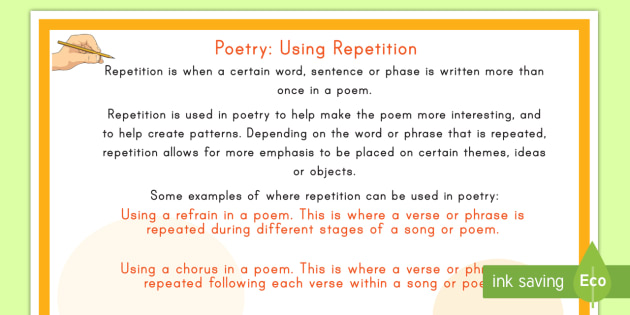
Repetition, a fundamental element of language, plays a crucial role in shaping the impact and effectiveness of written communication. By consciously repeating words, phrases, or grammatical structures, writers can amplify their message, create memorable rhythms, and guide readers through complex ideas. Understanding the power of repetition and its various applications is essential for crafting compelling and persuasive writing.
This article delves into the world of repetition in writing, exploring its definition, different types, effective techniques, and the profound impact it has on the overall reading experience. We will examine how repetition can enhance clarity, memorability, and the emotional resonance of your writing, ultimately empowering you to become a more skilled and impactful communicator.
What is Repetition in Writing?
Repetition, simply put, is the act of using the same word, phrase, or grammatical structure multiple times within a piece of writing. This deliberate recurrence serves several purposes, from emphasizing key concepts to creating a sense of rhythm and flow. While it might seem like a simple technique, repetition can be incredibly powerful when used strategically.
Effective repetition goes beyond simply stating the same word repeatedly. It involves incorporating variations and nuances to maintain reader interest while still driving home the intended message. For instance, instead of saying “The cat was happy” three times in a row, you could say “The cat purred with happiness,” “The cat’s tail swished contentedly,” and “A smile played on the cat’s face.”
Types of Repetition

There are various types of repetition, each serving a distinct purpose:
Anaphora
Anaphora involves repeating the same word or phrase at the beginning of successive clauses or sentences. This technique creates a powerful sense of rhythm and emphasis, often used to build momentum and drive home a point.
Example: “We shall fight on the beaches, we shall fight on the landing grounds, we shall fight in the fields and in the streets, we shall fight in the hills; we shall never surrender.” – Winston Churchill
Epistrophe
Epistrophe is the opposite of anaphora, where the same word or phrase is repeated at the end of successive clauses or sentences. This creates a sense of closure and finality, often used to emphasize the concluding thought.
Example: “Government of the people, by the people, for the people, shall not perish from this earth.” – Abraham Lincoln
Parallelism
Parallelism involves using similar grammatical structures to express related ideas. This technique creates a sense of balance and harmony, making complex ideas easier to understand.
Example: “She likes to read, to write, and to think.”
Techniques for Effective Repetition
While repetition is a powerful tool, it’s crucial to use it effectively. Here are some tips:
- Don’t overdo it: Too much repetition can become monotonous and detract from your writing. Use it sparingly and strategically.
- Vary your wording: Instead of repeating the same word or phrase verbatim, try using synonyms or slightly different phrasing to keep things interesting.
- Consider context: The type of repetition you choose should depend on the tone and purpose of your writing. Anaphora is great for building momentum, while epistrophe creates a sense of closure.
Impact of Repetition on Writing

Repetition has a profound impact on how readers perceive and engage with your writing:
- Emphasis: By repeating key words or phrases, you draw attention to important ideas and concepts.
- Memorability: Repetition helps readers remember key information, making your writing more impactful.
- Rhythm and Flow: Repetition creates a sense of rhythm and flow, making your writing more enjoyable to read.
- Emotional Resonance: Repetition can be used to evoke emotions in readers, creating a deeper connection with your message.
Benefits of Using Repetition
Incorporating repetition into your writing offers numerous benefits:
- Clarity: Repetition can help clarify complex ideas by emphasizing key points and simplifying language.
- Persuasion: By repeating persuasive arguments, you can strengthen your case and influence readers’ opinions.
- Engagement: Repetition keeps readers engaged by creating a sense of rhythm and anticipation.
- Professionalism: Skilled use of repetition demonstrates your command of language and attention to detail.
Conclusion
Repetition is a powerful literary device that can significantly enhance the effectiveness of your writing. By understanding its various types, techniques, and impacts, you can leverage repetition to create compelling, memorable, and impactful content. Remember to use it strategically and sparingly, always considering the context and purpose of your writing. Mastering the art of repetition will elevate your writing skills and allow you to communicate with greater clarity, persuasion, and emotional resonance.
